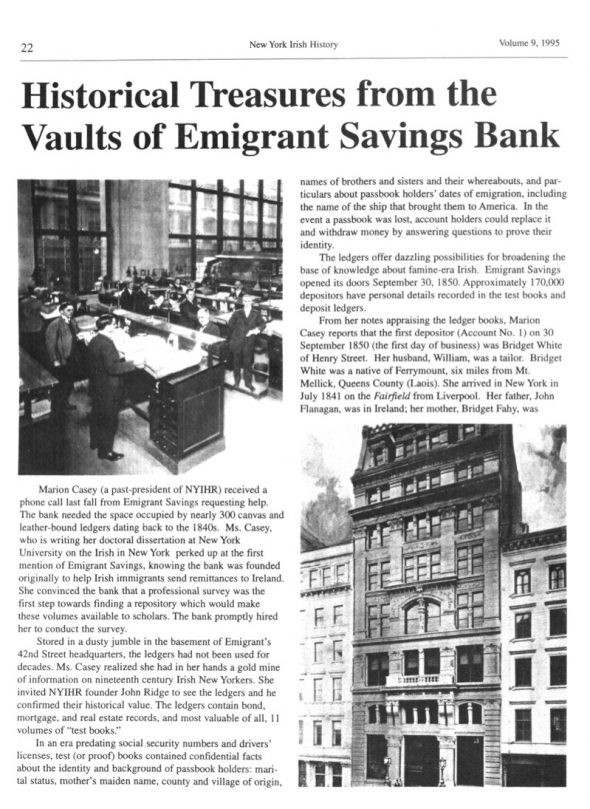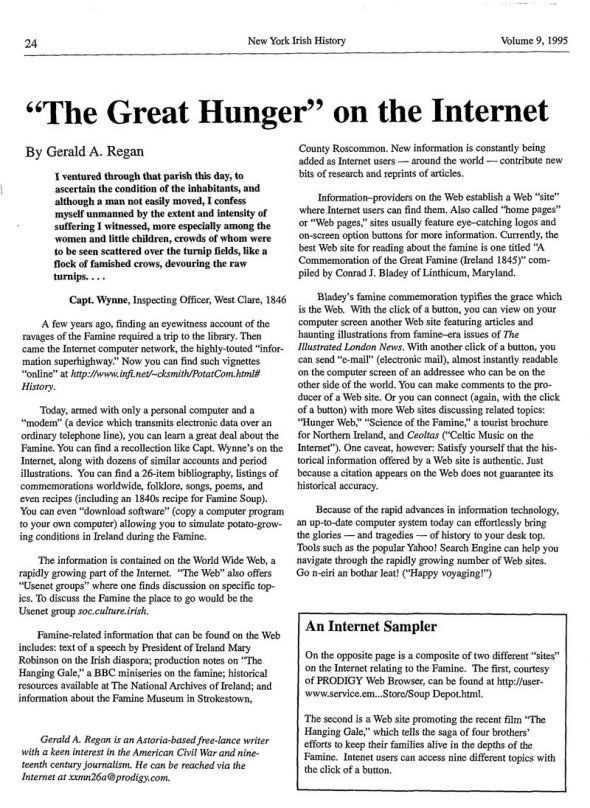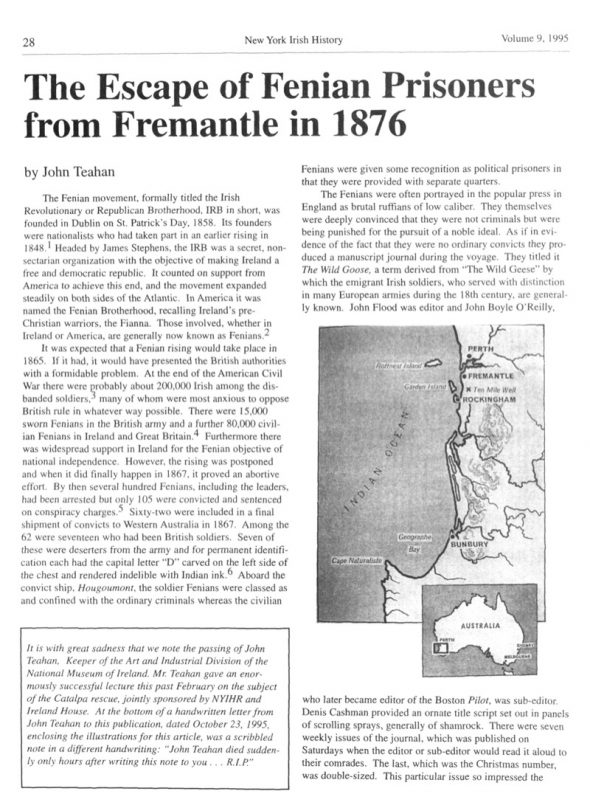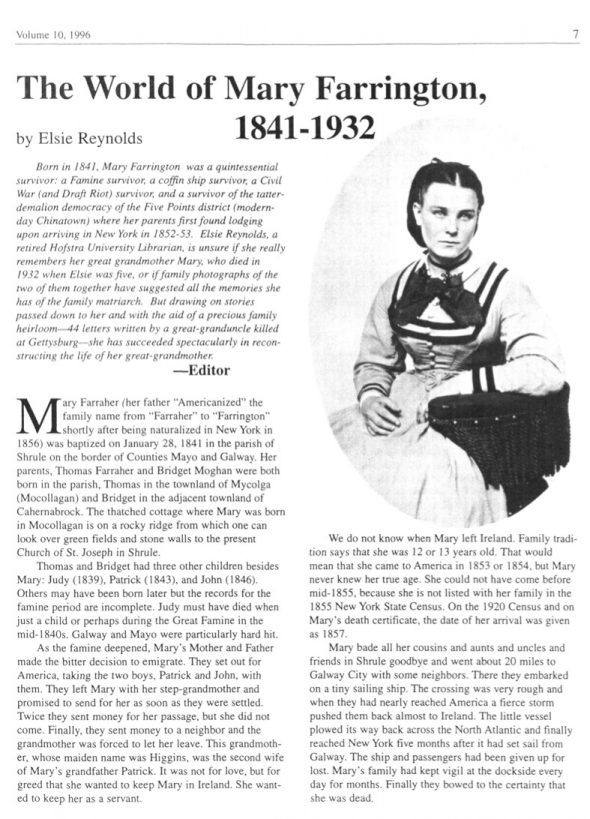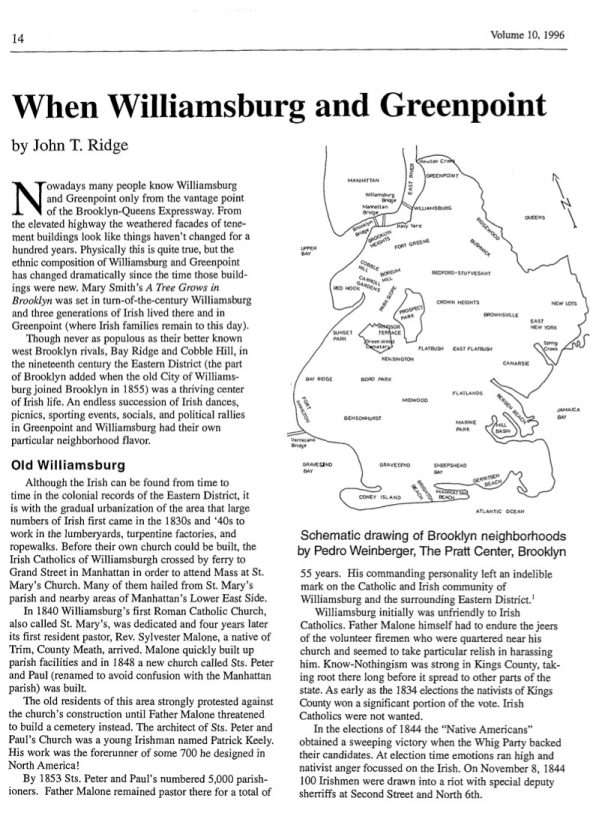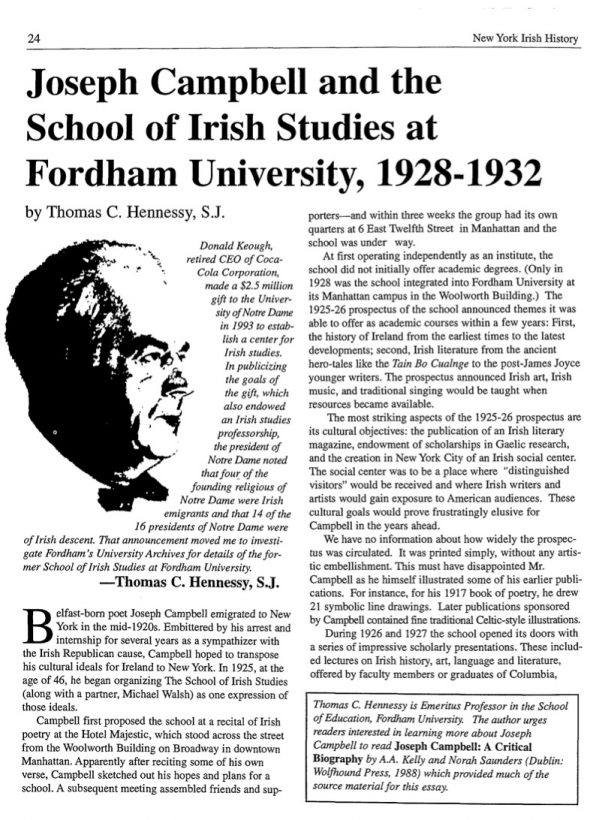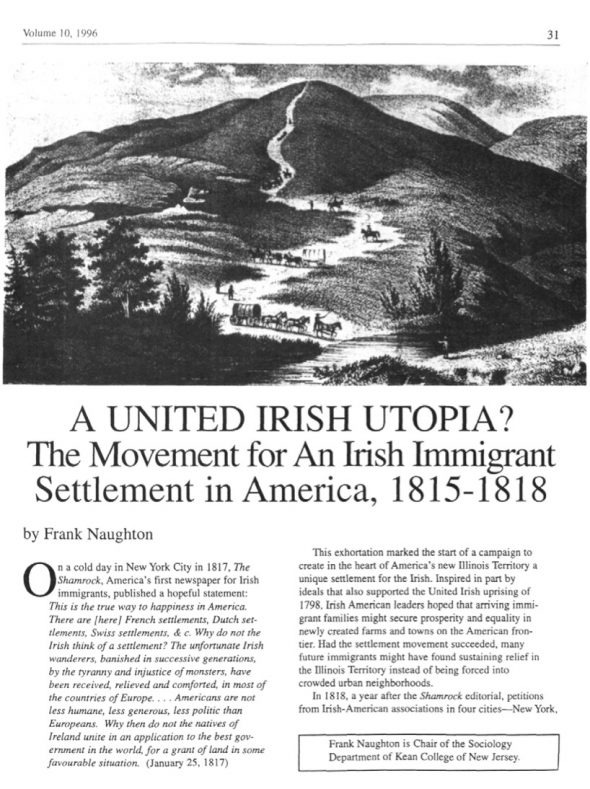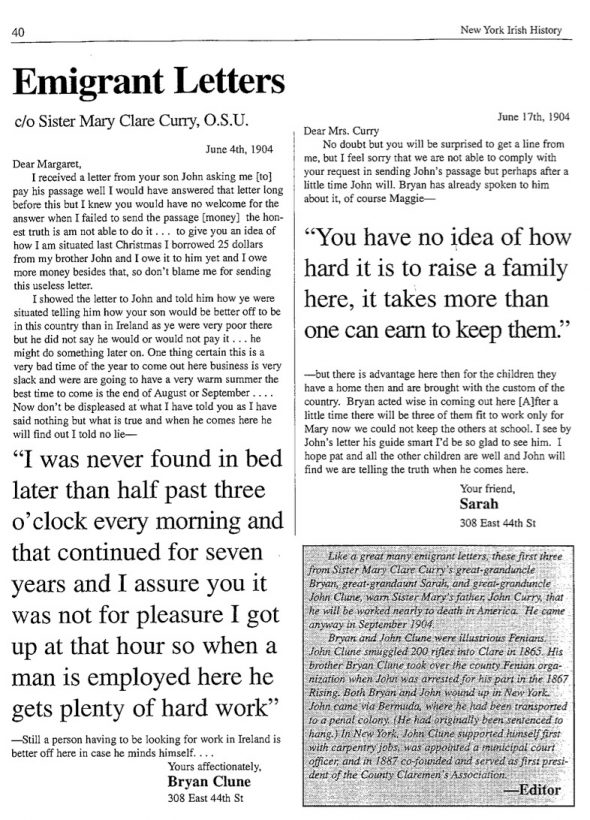New York Irish History Roundtable - Journal Articles
Historical Treasures from the Vaults of Emigrant Savings Bank
Author: New York Irish History Roundtable
Publication Year: 1995
Journal Volume: 09
Article Reference: NYIHR-V09-07
Marion Casey (a past-president of NYIHR) received a phone call last fall from Emigrant Savings requesting help.
The bank needed the space occupied by nearly 300 canvas and leather-bound ledgers dating back to the 1840s. Ms. Casey, who is writing her doctoral dissertation at New York University on the Irish in New York perked up at the first mention of Emigrant Savings, knowing the bank was founded originally to help Irish immigrants send remittances to Ireland.
She convinced the bank that a professional survey was the first... [Read Full Article]
The Great Hunger on the Internet
Author: Gerald A. Regan
Publication Year: 1995
Journal Volume: 09
Article Reference: NYIHR-V09-08
I ventured through that parish this day, to ascertain the condition of the inhabitants, and although a man not easily moved, I confess myself unmanned by the extent and intensity of suffering I witnessed, more especially among the women and little children, crowds of whom were to be seen scattered over the turnip fields, like a flock of famished crows, devouring the raw turnips.... Capt. Wynne, Inspecting Officer, West Clare, 1846 A few years ago, finding an eyewitness account of the ravages of the Famine required a trip to the library.... [Read Full Article]
The Escape of Fenian Prisoners from Fremantle in 1876
Author: John Teahan
Publication Year: 1995
Journal Volume: 09
Article Reference: NYIHR-V09-09
The Fenian movement, formally titled the Irish Revolutionary or Republican Brotherhood, IRB in short, was founded in Dublin on St. Patrick's Day, 1858. Its founders were nationalists who had taken part in an earlier rising in 1848.
Headed by James Stephens, the IRB was a secret, nonsectarian organization with the objective of making Ireland a free and democratic republic. It counted on support from America to achieve this end, and the movement expanded steadily on both sides of the Atlantic. In America it was named the Fenian... [Read Full Article]
Family History, Tracking Down Long-Lost Relatives
Author: Betty (Elizabeth Caven-Wilhelm)
Publication Year: 1995
Journal Volume: 09
Article Reference: NYIHR-V09-10
The New York Irish History Roundtable received the following "shot-in-the-dark" inquiry letter from New South Wales, inquiring about a relative lost 60 years ago somewhere "in the USA." The painstaking efforts by NYIHR member Elizabeth Caven-Wilhelm to help Mr. Woodcock, recorded in the letter below, constitute virtually a primer on how to track down long-lost relatives. Can any NYIHR members, by any chance, provide a clue to the whereabouts of John Edward"Manny" Watson? 12 April 1995 Dear Sir/Madam, I am writing this letter in the hope... [Read Full Article]
The World of Mary Farrington, 1841-1932
Author: Elsie Reynolds
Publication Year: 1996
Journal Volume: 10
Article Reference: NYIHR-V10-01
Born in 1841, Mary Farrington was a quintessential survivor: a Famine survivor, a coffin ship survivor, a Civil War (and Draft Riot) survivor, and a survivor of the tatterdemalion democracy of the Five Points district (modernday Chinatown) where her parents first found lodging upon arriving in New York in 1852-53. Elsie Reynolds, a retired Hofstra University Librarian, is unsure if she really remembers her great grandmother Mary, who died in 1932 when Elsie was five, or if family photographs of the two of them together have suggested all... [Read Full Article]
When Williamsburg and Greenpoint were Irish
Author: John T. Ridge
Publication Year: 1996
Journal Volume: 10
Article Reference: NYIHR-V10-02
Nowadays many people know Williamsburg and Greenpoint only from the vantage point of the Brooklyn-Queens Expressway. From the elevated highway the weathered facades of tenement buildings look like things haven't changed for a hundred years. Physically this is quite true, but the ethnic composition of Williamsburg and Greenpoint has changed dramatically since the time those buildings were new. Mary Smith's A Tree Grows in Brooklyn was set in turn-of-the-century Williamsburg and three generations of Irish lived there and in Greenpoint (where... [Read Full Article]
Joseph Campbell and the School of Irish Studies atFordham University, 1928-1932
Author: Thomas C. Hennessy, SJ.
Publication Year: 1996
Journal Volume: 10
Article Reference: NYIHR-V10-03
Donald Keough, retired CEO of Coca-Cola Corporation, made a $2.5 million gift to the University of Notre Dame in 1993 to establish a center for Irish studies.
In publicizing the goals of the gift, which also endowed an Irish studies professorship, , the president of Notre Dame noted that four of the founding religious of Notre Dame were Irish emigrants and that 14 of the 16 presidents of Notre Dame were of Irish descent. That announcement moved me to investigate Fordham's University Archives for details of the former School of Irish... [Read Full Article]
A United Irish Utopia? The Movement For An Irish Immigrant Settlement in America, 1815-1818
Author: Frank Naughton
Publication Year: 1996
Journal Volume: 10
Article Reference: NYIHR-V10-04
On a cold day in New York City in 1817, 77ie Shamrock, America's first newspaper for Irish immigrants, published a hopeful statement: This is the true way to happiness in America.
There are [here] French settlements, Dutch settlements, Swiss settlements, & c. Why do not the Irish think of a settlement? The unfortunate Irish wanderers, banished in successive generations, by the tyranny and injustice of monsters, have been received, relieved and comforted, in most of the countries of Europe. . . . Americans are not less humane, less... [Read Full Article]
Emigrant Letters care of Sister Mary Clare Curry, O.S.U.
Author: Sister Mary Clare Curry, O.S.U.
Publication Year: 1996
Journal Volume: 10
Article Reference: NYIHR-V10-05
Emigrant Letters c/o Sister Mary Clare Curry, O.S.U. June 4th, 1904 Dear Margaret, I received a letter from your son John asking me [to] pay his passage well I would have answered that letter long before this but I knew you would have no welcome for the answer when I failed to send the passage [money] the honest truth is am not able to do it... to give you an idea of how I am situated last Christmas I borrowed 25 dollars from my brother John and I owe it to him yet and I owe more money besides that, so don't blame me for sending this... [Read Full Article]
The Life and Times of Muldoon, the Solid Man
Author: Don Meade
Publication Year: 1997
Journal Volume: 11
Article Reference: NYIHR-V11-01
"Muldoon, the Solid Man," a comic song first performed in 1874, is the most enduringly popular composition of New York Irish playwright, director, actor, lyricist and singer Edward Harrigan. The multi-talented Harrigan, most famous as half of the theatrical team of Harrigan and Hart, is a towering figure in the history of the American stage and is one of the founding fathers of modern musical comedy. Harrigan was an amazingly prolific writer who cranked out scores of successful plays and sketches, as well as the lyrics for over 300 songs.... [Read Full Article]

